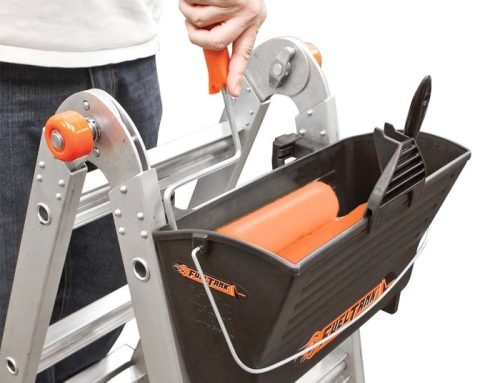Health professionals are often the first people to deal with the aftermath of a ladder accident and they see so many, that they are often more well equipped to make safety improvements than ladder designers, seeing first-hand what actually goes wrong in the real world. A paramedic, in Australia, has designed a safety accessory for extension ladders that will make them safer for domestic users and reduce the number of accidents caused by ladders being improperly secured at the top.
David Kay came up with the initial concept around 16 years ago, but was astounded to learn that no-one else had dreamt up the same notion when he recently started serious work on prototypes and patents with engineer friend Daniel Seidel. The Lacket, as it is called, affixes to the ladder and can be left in place at all times. The device jams against the fascia (or any overhanging feature) of a house, securing it to the surface so it cannot move at the top. Once in place the Lacket stops the ladder from moving sideways or falling backwards and means the ladder is fully secured at the top without anyone needing to climb it. The Lacket comes with a ground pin and straps that can be used to fix the ladder at the base as well, covering both points of security in one product. The Lacket is easy to fit to most straight ladders and very easy to deploy – it can be done by one person (as long as they are strong enough to safely extend and move the ladder to the right place). Although Lacket state that ladders should never be used alone, the inclusion of the ground straps means that this can be done in situations where it is not possible to have another person helping.
The issue of being able to tie a ladder off at the top is one of the main causes of ladder falls, as it can be an arduous process involving the removal of roof tiles or screwing a large anchor bolt into the side of the building. While a person is trying to secure a ladder in this way they must use an unsecured ladder to do so, which does not really make the process of using the ladder any safer. Due to the work involved in creating a safe anchor point for the top of a ladder, many people forego this step and work on an unsecured ladder, leading to slips and falls that could otherwise be avoided.
The Lacket is aimed at the domestic and trade markets alike, as Kay has seen first-hand the effects and ongoing rehabilitation involved in most ladder related accidents in the home and the workplace. It was even shortlisted as a finalist in the 2017 WorkSafe Awards, although it did not win against the strong competition. The Lacket is available to pre-order online and will be available from mid-2018.






Leave A Comment
You must be logged in to post a comment.